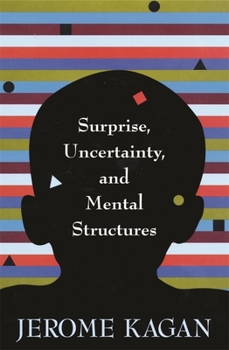Surprise, Uncertainty, and Mental Structures
Select Format
Select Condition 
Book Overview
When we are startled by the new, confronted with discrepancies, our knowing gives way to uncertainty--and changes. In the distinctive manner that has made him one of the most influential forces in developmental psychology, Jerome Kagan challenges scientific commonplaces about mental processes, pointing in particular to the significant but undervalued role of surprise and uncertainty in shaping behavior, emotion, and thought.
Format:Hardcover
Language:English
ISBN:0674007352
ISBN13:9780674007352
Release Date:April 2002
Publisher:Harvard University Press
Length:272 Pages
Weight:1.00 lbs.
Dimensions:1.0" x 5.7" x 8.5"
Customer Reviews
1 rating
Positive statement of Kagan's view of mind
Published by Thriftbooks.com User , 17 years ago
If you've read a significant amount of Jerome Kagan's work, the ideas here will not be new to you; but the form of exposition will. This book is basically a statement of Kagan's theory of mind, and of how psychology ought to be pursuing research into mind. While this theory has appeared in bits and pieces in connection with his research on temperament and child development, and especially in his criticisms of research he considers inadequate, this is, I believe, the only place where Kagan has stated the theory directly, with sustained argument. Essentially, the argument is that psychology needs to shift from studying psychological functions (memory, perception, mood, etc.) to looking for the structures that inform and produce these functions. Kagan believes two very different, but related, structures are the place to start: semantic networks--basically, abstract concepts--and schematic representations--which are the more concrete, emotion and action-laden, imagistic modes of structuring experience. I find Kagan's theory and argument for these two types of structure and their relations with each other highly persuasive. In particular, Kagan's view does a great deal to illuminate the vexed questions around how out-of-awareness processing takes place. I'm not sure why an earlier reviewer portrayed this argument as a polemic against questionnaire research. While Kagan does have a few pages on the topic in the book, to illustrate his theory and how he thinks better research should be done, this topic is by no stretch of the imagination the main point of the book. I find this book immensely helpful in organizing my thinking about the immense bodies of research that have emerged in recent years on disparate types of mental function. One caveat: If you know Kagan's body of work, you know that his writing varies wildly. Sometimes he's clear and accessible, sometime dry, dense, and abstruse. This book falls somewhere in the middle. While it is clearer and easier to read than some of his work, the writing can be a bit fastidious and at times, shall we say, overly precise--you have to cycle through the various meanings of the words he uses to figure out in what sense he's using them, for some sentences are less than immediately transparent. But the power of the theory to organize immense amounts of data, and to direct one's thinking about mind's diverse regions, is, quite literally, awesome.





